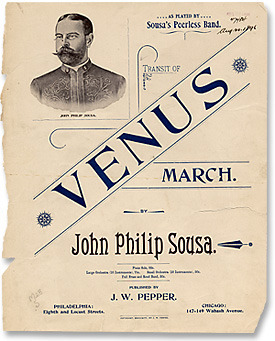The transit of Venus in popular culture
In 1883, John Philip...

The transit of Venus in popular culture
In 1883, John Philip Sousa wrote a march to commemorate the transit of Venus — which had captivated the world’s imagination just a few months before in Dec. 1882. Like popular interest in the transit itself, Sousa’s march quickly returned to obscurity, mostly unperformed for more than a century. But in the buildup to the 2004 transit of Venus, bands and orchestras around the world dusted off Sousa’s score and gave the old calliope a twirl once again. (One rock band from Virginia updated the soundtrack with a 2011 song called “Venus Transit.”)
In a slightly less astronomical vein, novelist Shirley Hazzard won the 1990 National Book Critics Circle Award for her poetic novel about the peripatetic lives of two orphan sisters called The Transit of Venus. (New Yorker online book club chat about the novel here.) From the book’s summary by GoodReads
The Transit of Venus is considered Shirley Hazzard’s most brilliant novel. It tells the story of two orphan sisters, Caroline and Grace Bell, as they leave Australia to start a new life in post-war England. What happens to these young women — seduction and abandonment, marriage and widowhood, love and betrayal — becomes as moving and wonderful and yet as predestined as the transits of the planets themselves. Gorgeously written and intricately constructed, Hazzard’s novel is a story of place: Sydney, London, New York, Stockholm; of time: from the fifties to the eighties; and above all, of women and men in their passage through the displacements and absurdities of modern life.
(hat tip to G.R.A.)



